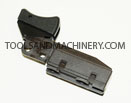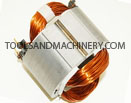Many of us have a power tool or two that has just seen better days. Wear and tear can effect your power tool both inside and out, and overtime it’s no surprise that sometimes a tool can just go belly up. Of course, all is not lost, if your tool just won’t start, there are only a few simple steps to finding out how to get her kicking again.
 Firstly, because brushes are fairly simple to check, and are a common spoil of power tool wear and tear, check-out the tool’s carbon brushes first. Brush damage can look like a few different things: heavy wear, chips, heat-damage, or burrs (build-up around the brush that keeps it from making contact with the armature). Heavy-wear, chips, and heat damage are clearly visible, prevent electrical current from flowing, and require replacement; burrs, on the other hand, can usually be scraped away but may require replacement anyway. Because the tool will not engage if brushes don’t make complete contact with the armature, before moving on you need to be certain that the brush is capable of maintaining contact. If it can’t, it needs to be replaced, simple as that.
Firstly, because brushes are fairly simple to check, and are a common spoil of power tool wear and tear, check-out the tool’s carbon brushes first. Brush damage can look like a few different things: heavy wear, chips, heat-damage, or burrs (build-up around the brush that keeps it from making contact with the armature). Heavy-wear, chips, and heat damage are clearly visible, prevent electrical current from flowing, and require replacement; burrs, on the other hand, can usually be scraped away but may require replacement anyway. Because the tool will not engage if brushes don’t make complete contact with the armature, before moving on you need to be certain that the brush is capable of maintaining contact. If it can’t, it needs to be replaced, simple as that.
Hint: If the brushes are significantly damaged, it’s a good idea to move directly to checking the armature. Sometimes armature damage can prematurely wear or severely chip the brush’s carbon block, hence, intense brush damage can be an indicator of a damaged armature.
 Second, because a switch is quite a bit more delicate than an armature, you’ll want to take a look at your switch assembly next. Here, wear and tear usually comes in the form of heat damage which can look like burning or charring, or like colorful discoloration. The plastic or wires of the switch may even be melted; any of these would certainly be cause to keep your tool from firing up. A switch can also be damaged by water or moisture, which although more difficult to detect, is equally damaging to the performance of the part and the tool as well. If the switch appears burned or discolored, or if you know it has suffered water damage, the assembly must be replaced. If this is your only problem, replacing the switch should get you re-rolling smoothly.
Second, because a switch is quite a bit more delicate than an armature, you’ll want to take a look at your switch assembly next. Here, wear and tear usually comes in the form of heat damage which can look like burning or charring, or like colorful discoloration. The plastic or wires of the switch may even be melted; any of these would certainly be cause to keep your tool from firing up. A switch can also be damaged by water or moisture, which although more difficult to detect, is equally damaging to the performance of the part and the tool as well. If the switch appears burned or discolored, or if you know it has suffered water damage, the assembly must be replaced. If this is your only problem, replacing the switch should get you re-rolling smoothly.
Hint: Although brushes are generally easier to check, switches are more commonly the culprit in a tool that will not engage. Additionally, and just like your brushes, sometimes your switch will simply wear-out and require replacement with or without visible signs of damage.
 Well, now it’s now time to revisit that armature. First, take a look at the commutator bars, or the things your brushes connect with along the electrical path. The bars should form a perfect circle; if any bars are raised or missing this can cause brush damage and non-contact with the brushes. The commutators, as well as the rest of the assembly, may have also suffered some heat-damage; this will, again, look like burning, charring, melting, or colorful discoloration of the metal. If you have heat damage on your armature, chances are your other components will be in the red-zone as well. A damaged armature must be replaced quickly.
Well, now it’s now time to revisit that armature. First, take a look at the commutator bars, or the things your brushes connect with along the electrical path. The bars should form a perfect circle; if any bars are raised or missing this can cause brush damage and non-contact with the brushes. The commutators, as well as the rest of the assembly, may have also suffered some heat-damage; this will, again, look like burning, charring, melting, or colorful discoloration of the metal. If you have heat damage on your armature, chances are your other components will be in the red-zone as well. A damaged armature must be replaced quickly.
Hint: In addition to causing brush damage, damaged commutators can also cause arcing within the tool which will manifest to the user as a loss of power and performance. Remember also that when you experience a lack of power or performance, all the tool’s components are overworking and likely overheating as well which leads, of course, to heat-damage. If you’re not careful you’ll be dumb-struck by a tool with a bunch a fried-up components.
 Next on the checklist is your field; if your field is damaged you will again see burning, melting, or discoloration of the body, wire, or insulation. Additionally, before it goes kaput, the tool will feel sluggish or unambitious with a general lack of power and performance. Field damage most commonly occurs as a result of overlaoding or overheating within the tool (which is a result over misusing or abusing the tool). If the field is damaged, it, like the armature, should be replaced quickly.
Next on the checklist is your field; if your field is damaged you will again see burning, melting, or discoloration of the body, wire, or insulation. Additionally, before it goes kaput, the tool will feel sluggish or unambitious with a general lack of power and performance. Field damage most commonly occurs as a result of overlaoding or overheating within the tool (which is a result over misusing or abusing the tool). If the field is damaged, it, like the armature, should be replaced quickly.













